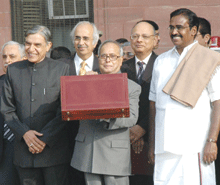 On the eve of the general election scheduled for this summer, the Congress-led UPA government at the Centre presented a lacklustre interim vote-on-account (budget) for fiscal 2009-10. The constitutionally prim and proper Rs.953,231 budget presented to Parliament on February 16 by Union external affairs minister Pranab Mukherjee in the absence of prime and finance minister Dr. Manmohan Singh (recovering from heart surgery), raised the education outlay of the Union government for 2009-10 by 12.5 percent to Rs.41,978.21 crore, over the revised estimated expenditure of Rs.37,366.57 crore in fiscal 2008-09 (budgeted: Rs.34,400 crore).
On the eve of the general election scheduled for this summer, the Congress-led UPA government at the Centre presented a lacklustre interim vote-on-account (budget) for fiscal 2009-10. The constitutionally prim and proper Rs.953,231 budget presented to Parliament on February 16 by Union external affairs minister Pranab Mukherjee in the absence of prime and finance minister Dr. Manmohan Singh (recovering from heart surgery), raised the education outlay of the Union government for 2009-10 by 12.5 percent to Rs.41,978.21 crore, over the revised estimated expenditure of Rs.37,366.57 crore in fiscal 2008-09 (budgeted: Rs.34,400 crore).
The interim budget offered the UPA government its last chance to at least partially redeem its 2004 pledge to raise the educa-tion outlay to 6 percent of GDP, promised in its much-trumpeted CMP (common minimum programme) broadcast in 2004. But the timorous 12.5 percent higher allocation over last year’s outlay, indicates that during the past five years it had no intention of keeping its promise to India’s 450 million educationally short-changed children.
“The provision for education is grossly inadequate. More shocking is that as a percentage of GDP, it’s well below what the previous NDA government was spending. Not enacting the Right to Education Bill all these five years is the most glaring failure of this government,” says Dr. Jayati Ghosh, member of the National Knowledge Commission and professor of economics at Delhi’s showpiece Jawaharlal Nehru University.
In the interim budget, the allocation for Sarva Shiksha Abhiyaan has been maintained at Rs.13,100 crore. “About 98 percent of our habitations have been covered by primary schools and the focus is on improving the quality of elementary education. An allocation of Rs.8,000 crore has been made for the mid-day meals scheme,” Mukherjee said while describing 2008-09 as a “momentous year for secondary education”.
Signalling a shift in government priority to secondary education, while maintaining the status quo in the SSA outlay, Mukherjee made an allocation of Rs.1,143 crore towards a new Rashtriya Madhyamik Shiksha Abhiyaan (higher primary) scheme announced this year.
Moreover for construction of 6,000 new model secondaries, announced by prime minister Manmohan Singh in his Independence Day address in 2007, an amount of Rs.312.90 crore has been allocated in the interim budget 2009-10. RMSA aims to achieve an enrollment ratio of 75 percent within five years and universal retention by 2020 under the centre-states funding model pioneered in SSA.
Yet it is pertinent to note that the budget provision of Rs.312.90 crore for establishing 6,000 model secondaries translates into a mere Rs.5.20 lakh per school. As to what magic wand the stand-in finance minister will wave to construct a secondary — that too a model secondary — at Rs.5.20 lakh must remain an enduring mystery. According to construction industry sources, even if the land is free, the mere building cost of a secondary for 500-1,000 students will aggregate four times the budgeted amount.
Moreover in his budget speech, Mukherjee highlighted that higher education spending will be 900 percent greater in the Eleventh Plan period (2007-12), while allocating an unprecedented Rs.13,179 crore for this sector. He reminded the country that an ordinance to inaugurate 15 Central universities has been promulgated, six new IITs have started functioning with two more expected to commence their academic sessions in 2009-10; five Indian Institutes of Science Education and Research have become operational and classes have commenced in four out of the six new IIMs proposed.
Yet while obviously echoing the official Congress Party line and making all the right noises about the importance of education for national development, it’s quite evident that during the past five years the UPA government has muffed a great opportunity to move education to the top of its development agenda. Last year following the presentation of the fourth Union budget of the UPA government, EducationWorld presented the Congress party and public a detailed blueprint of ways and means to triple Central government outlay for education to Rs.100,000 crore (see EW April 2008) as a sure-fire formula to sweep the next general election. This advice was ignored with the road map unacknowledged.
Instead as evident in the last budget of its five-year term in office, the Congress leadership continues to believe that token incremental budgeting will solve the deep-rooted problems of Indian education, and a miracle will enable it to reap the country’s demographic dividend. This inability to think out of the box could well cost it the next election.
Autar Nehru (Delhi)